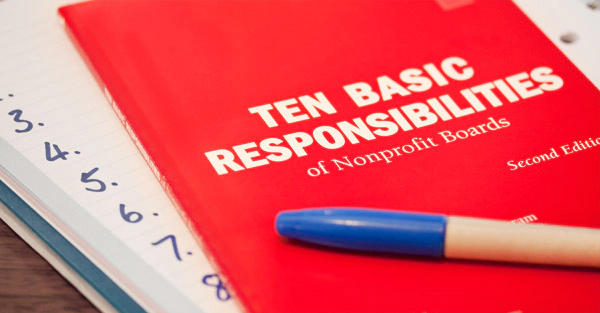book-review
Ten Basic Responsibilities of Nonprofit Boards – Book Review
Published: November 12, 2012
Read Time: 4 minutes

Richard T. Ingram’s Ten Basic Responsibilities of Nonprofit Boards, Second Edition (2008) is a handy manual on the basics of board governance.
The text is the first publication in the popular Governance Series produced by Board Source. The series is authored by a range of writers with experience in the non-profit sphere and is designed as a point of entry to non-profit boards and a range of topics that surround effective governance. Richard T. Ingram is president emeritus of the Association of Governing Boards of Universities and Colleges (USA) and has had a long career both consulting for and serving on non-profit boards.
Ingram’s approach is straightforward and succinct and the book is well constructed and accessible. The format of brief (sometimes only a couple of pages) chapters that are clearly labelled allows readers to quickly locate the relevant topic. With a background in education, Ingram has the necessary expertise to instruct readers in a helpful and productive manner.
Ingram adopts an open and analytical style. He does not assert strong opinions on each topic but poses issues for discussion or clarification amongst the board. Ten Basic Responsibilities of Nonprofit Governance does not simply outline the role of board members but also intimates at the industrious and positive attitude required by board members in order play an effective role in the organisation.
*Ten Basic Responsibilities of Nonprofit Boards_ succinctly introduces ten essential elements of serving on a board in clearly set out chapters. Each chapter is succinct and offers a valuable introduction to a wide range of issues. The topics grow from the central drive of the organisation: the mission, to financial tactics and quality of service monitoring and then to board development and marketing. The progress of the book maps the development and growth of the concerns of non-profit organisations. Although introductory, Ingram has a critical approach to each issue and approaches it from multiple angles, or seeks to call attention to contentious elements.
Each chapter contains action boxes with tips and pitfalls relating to each responsibility that offers specific advice regarding potential challenges. The book also includes appendices addressing individual board member responsibilities, offering a model for board self-assessment and suggesting some further reading.
In addition to general advice Ingram offers some tips on the best way to conduct yourself on a board and what will be expected of you personally as a representative of the organisation. Ingram helps readers to differentiate between the role of the board and that of the staff. He clearly demarcates the big picture approach of the board from the operational focus of staff. Ingram proposes that board members’ expertise is best used in the development of policy, rather than in taking responsibility for operational tasks. Even if a board member has skills in a particular area, such as auditing, he argues that it is best to rely on a staff member or external contractor rather than directly utilising the skills of board members in this way.
Ten Basic Responsibilities of Nonprofit Boards is an introductory text and will largely only be suitable for new or prospective board members with limited experience of board processes. Veteran board members may benefit from a glimpse through the text if they need to be reminded of the fundamentals, but are unlikely to encounter new information. Unlike other similar texts, Ten Basic Responsibilities of Nonprofit Boards contains a distinct lack of case studies or real-world examples. Although these are can be an invaluable tool for understanding outcomes and implications, many readers will appreciate the way in which Ingram simply and economically imparts only the essential information.
It is important for readers to keep in mind that this is an American publication and adopts some terminology and holds some positions that may be unfamiliar or inapplicable to the Australian non-profit sphere. Readers should also be cautious before taking at face value any tax-related or legal advice. Given that Ten Basic Responsibilities of Nonprofit Boards is an introductory text and generalist in nature, however, much of its content remains valuable to Australian readers. In the limited space available in such a petite text, Ingram skilfully imparts wise advice about the most appropriate and effective attitude that board members can have.
Ten Basic Responsibilities of Nonprofit Boards offers a valuable introduction to board processes. It advises board members on the most efficient and effective practices in order to encourage them to be productive in the governance of their organisation. Ingram’s success in the distilling the essential elements of board membership is evinced in the reported more than 175,000 copies of the book sold.
Published by Board Source, 2008. 90 pages.
Share this Article
Recommended Reading
Recommended Viewing
Author
-
Former Researcher
Better Boards
- About
-
At the time of writing Julia was a writer and researcher at Better Boards. She has a passionate interest in the non-profit sector, particularly its legal and regulatory complexities and she follows all news and developments in this area keenly. Prior to joining Better Boards, Julia served as an intern at Philanthropy Australia. Julia has a Bachelor of Arts from the University of Melbourne, majoring in Political Science and English Literature.
Found this article useful or informative?
Join 5,000+ not-for-profit & for-purpose directors receiving the latest insights on governance and leadership.
Receive a free e-book on improving your board decisions when you subscribe.
Unsubscribe anytime. We care about your privacy - read our Privacy Policy .







